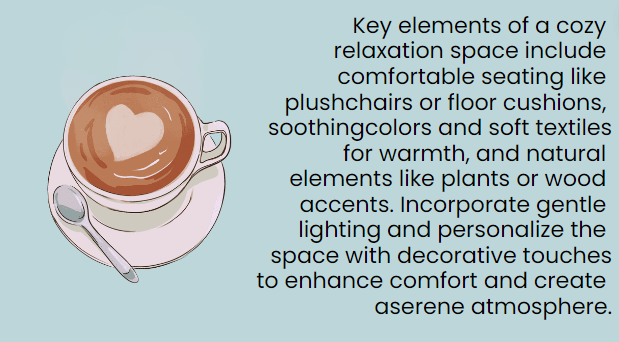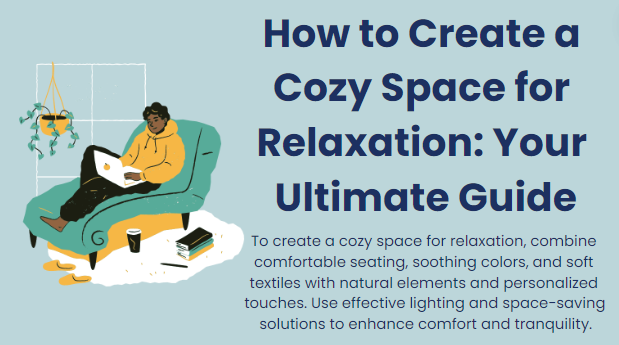In today’s fast-paced world, having a cozy space to unwind and relax is more important than ever. Whether you’re looking to transform a corner of your bedroom, a section of your living room, or even an entire room dedicated to relaxation, this guide will walk you through the essential steps to create your perfect sanctuary.
Understanding the Importance of a Relaxation Space
Before we dive into the practical steps, let’s consider why having a cozy space for relaxation is crucial:
- Stress reduction
- Improved mental health
- Better sleep quality
- Increased productivity
- Enhanced overall well-being
Key Elements of a Cozy Relaxation Space
To create the perfect cozy nook, consider incorporating these key elements:
- Comfortable seating
- Soft lighting
- Calming colors
- Plush textures
- Natural elements
- Personal touches
See also>> How to Make Healthy Eating Easy on a Busy Schedule
Let’s explore each of these elements in more detail.
1. Comfortable Seating
The foundation of any relaxation space is comfortable seating. This could be:
- A plush armchair
- A cozy loveseat
- Floor cushions or poufs
- A hanging chair or hammock
| Seating Option | Pros | Cons |
| Armchair | Supportive, classic | Takes up space |
| Floor cushions | Versatile, space-saving | May not suit all users |
| Hanging chair | Unique, fun | Requires sturdy mounting |
Choose seating that fits your space and personal preferences. Remember, comfort is key!
2. Soft Lighting
Harsh overhead lighting can disrupt the cozy atmosphere you’re trying to create. Instead, opt for:
- Table lamps with warm bulbs
- String lights or fairy lights
- Dimmable floor lamps
- Candles (real or LED)
The goal is to create a warm, gentle glow that helps you relax and unwind.
3. Calming Colors
The colors you choose for your relaxation space can significantly impact your mood. Consider these calming hues:
- Soft blues
- Gentle greens
- Warm neutrals
- Muted purples
Avoid bright, energizing colors like red or orange in your cozy nook.
4. Plush Textures
Incorporating soft, tactile elements can make your space feel instantly cozier. Try adding:
- Chunky knit blankets
- Velvet or faux fur pillows
- A thick, soft area rug
- Textured wallpaper or wall hangings
The more textures you incorporate, the more inviting your space will feel.
5. Natural Elements
Bringing a touch of nature into your relaxation space can help create a sense of calm. Consider:
- Potted plants or herbs
- A small indoor fountain
- Natural wood accents
- Stone or crystal decorations
| Natural Element | Benefits | Maintenance Level |
| Potted plants | Air purifying, visually appealing | Medium |
| Indoor fountain | Soothing sounds, humidity boost | High |
| Wood accents | Warmth, natural beauty | Low |
See also>> How to Eat Healthy on a Tight Budget: A Comprehensive Guide
Choose elements that resonate with you and fit your lifestyle.
6. Personal Touches
Finally, make the space truly yours by adding personal touches:
- Framed photos or artwork
- A collection of your favorite books
- Meaningful keepsakes or mementos
- A cozy scent (via candles or essential oils)
These personal elements will make your relaxation space feel uniquely yours.

Creating Your Cozy Space: A Step-by-Step Guide
Now that we’ve covered the key elements, let’s walk through the process of creating your cozy relaxation space:
- Choose your location
- Declutter and clean the area
- Select a color palette
- Add comfortable seating
- Layer in soft textiles
- Incorporate gentle lighting
- Bring in natural elements
- Add personal touches
- Create a relaxing ambiance with scent
- Maintain and adjust as needed
Remember, creating a cozy space is an ongoing process. Don’t be afraid to make changes as you discover what works best for you.
Making the Most of Small Spaces
If you’re working with limited square footage, don’t worry! Here are some tips for creating a cozy relaxation space in a small area:
- Use vertical space (wall-mounted shelves, hanging plants)
- Opt for multifunctional furniture
- Use light colors to make the space feel larger
- Incorporate mirrors to create the illusion of more space
- Choose compact, space-saving furniture
| Small Space Solution | Example |
| Vertical storage | Floating shelves |
| Multifunctional furniture | Storage ottoman |
| Space-saving seating | Folding floor chair |
With a bit of creativity, even the smallest nook can become a cozy haven.

Technology in Your Relaxation Space
While the goal is to create a peaceful retreat, some carefully chosen technology can enhance your relaxation experience:
- A small Bluetooth speaker for soothing music
- A white noise machine
- A tablet for reading or guided meditations
- Smart lighting for easy ambiance control
Just be sure to keep screens and potentially stressful devices (like your work phone) out of your cozy space.
See also>> Understanding Anxiety: Tips to Feel Better
FAQs
Q: How much should I expect to spend on creating a cozy relaxation space?
A: The cost can vary greatly depending on your choices. You can create a cozy nook on a budget by upcycling items you already own or shopping secondhand. Alternatively, you could invest in high-quality, long-lasting pieces. Set a budget that works for you and prioritize the elements that matter most.
Q: Can I create a cozy space in a shared living area?
A: Absolutely! Use room dividers, curtains, or strategically placed furniture to carve out a dedicated relaxation area within a larger space. Communicate with your housemates about your needs and find a solution that works for everyone.
Q: How often should I change or update my relaxation space?
A: There’s no set rule, but it’s a good idea to reassess your space every few months. As seasons change or your needs evolve, you might want to make small adjustments. Major overhauls are typically only necessary if your current setup isn’t serving you well.
Q: What if I can’t paint or make permanent changes to my space?
A: No problem! Focus on elements you can easily change or remove, like textiles, lighting, and portable decor. Removable wallpaper or large tapestries can also dramatically change the look of a space without permanent alterations.
Q: How can I make my relaxation space work for multiple purposes?
A: Choose versatile furniture and incorporate smart storage solutions. A comfortable reading chair could double as a meditation spot, while a storage ottoman could hold yoga props or craft supplies. The key is to maintain the cozy, relaxing atmosphere while allowing for flexibility in use.
Conclusion
Creating a cozy space for relaxation is an investment in your mental health and overall well-being. By incorporating comfortable seating, soft lighting, calming colors, plush textures, natural elements, and personal touches, you can transform any area into a soothing sanctuary. Remember, the key is to create a space that resonates with you personally – a place where you can truly unwind, recharge, and find peace amidst the chaos of daily life.
